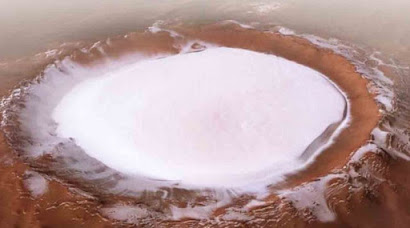NASA Study Results Call Lake in Turkey Similar to the Crater of Mars
Sunday, August 2, 2020
UPDATimes - The researchers studied data received by the Curiosity rover - a car-sized robot used to explore the planet Mars - found evidence of lakes filled with ice in the Gale crater on Mars.
Several billion years ago, the Gale crater on Mars was thought to be a lake.
It was even thought that there had previously been a river that filled water in the lake.
That's the conclusion of the scientists who worked with data from Curiosity explorer on Mars.
Curiosity landed in the Gale crater in August 2012 and continues to explore the area.
United States National Aeronautics and Space Administration (NASA) is conducting a unique study, visiting a lake in Turkey.
The study was conducted because the lake is similar to the Jazero crater on Mars. Based on the Anadolu Agency page, Sunday (2/8/2020) the similarity was seen from the mineral composition which was monitored by remote sensing and morphology.
In addition, according to Candan Gokceoglu, a professor of geological engineering at Hacettepe University in the Turkish capital, Ankara.
NASA Study Results Call Lake in Turkey Similar to the Crater of Mars
Now the results of studies from scientists at NASA add data on how conditions on Mars.
NASA announced the research on May 19, 2020. A peer-reviewed paper detailing these findings was published on January 27 in the journal Nature.
The results of these analysts came from research data collected decades from the rover and examined in a laboratory called Sample Analysis at Mars (SAM).
Jezero Crater is a landing site planned for NASA explorers in February when it will start a mission that will last for one Mars year, the equivalent of 687 Earth days.
Depression is estimated to form a lake of 28 miles - and possibly home to microbial life - according to the US space agency.
Not only that, Gokceoglu, who is also a member of the Turkish Environmental and Natural Assets Science Board, reposted NASA uploads on his Twitter account, where he showed similarities between Jezero and Salda.
"Even though it is located far away, Lake Salda, #Turkey, has geological similarities with the Jezero Crater in #Mars. In fact, researchers are doing field work on Lake Salda to prepare #CountdownToMars," wrote Prof. Gokceoglu.
"You might not be able to travel to Jezero Crater on Mars, but you can visit the next best thing: Lake Salda, Turkey," NASA Earth Observatory said.
"Despite its distance, Lake Salda shares the same mineralogy and geology as Lake Mars." he added.
SAM has analyzed a number of chemicals and minerals in rock samples, including organic compounds, to find out the habitat of parts of Mars and how the condition of the planet was before.
This test has previously confirmed abundant liquid water in the past, as well as various organic molecules remaining in Mars rocks.
Recent analysis has found evidence of a lake that was previously covered in ice in the Gale crater, thought to exist in cooler periods between two warmer periods of time.
Heather Franz, geochemist at Goddard Space Flight Center who led the new study, said that at one time, the Martian surface environment must have transitioned from warm and humid to cold and dry, like now, but when and how it happened was still a mystery.
The evidence supports the prediction that the climate of Mars alternates between warmer and colder before finally becoming permanently colder and drier as we see today.
Changes in planetary axis tilt and volcanic activity can be an important role in these unstable conditions.
Indeed, chemical and mineralogical changes in Mars also show this, with some layers of rock forming in warmer conditions, but others in cooler climates.
The finding of a lake in the Gale crater is based on 13 rock and dust samples collected.
Each sample is heated to 1,650 degrees Fahrenheit (900 degrees Celsius), to release trapped gas.
From this method it is known what minerals and gases come from within the rock.
The data is used to determine the carbon cycle on Mars, where gas changes on the surface of Mars, rock surfaces, water and the atmosphere.
Although Mars still has a carbon cycle today, it is far different from Earth, because the planet has little water and not many signs of life on the surface.





0 Comments